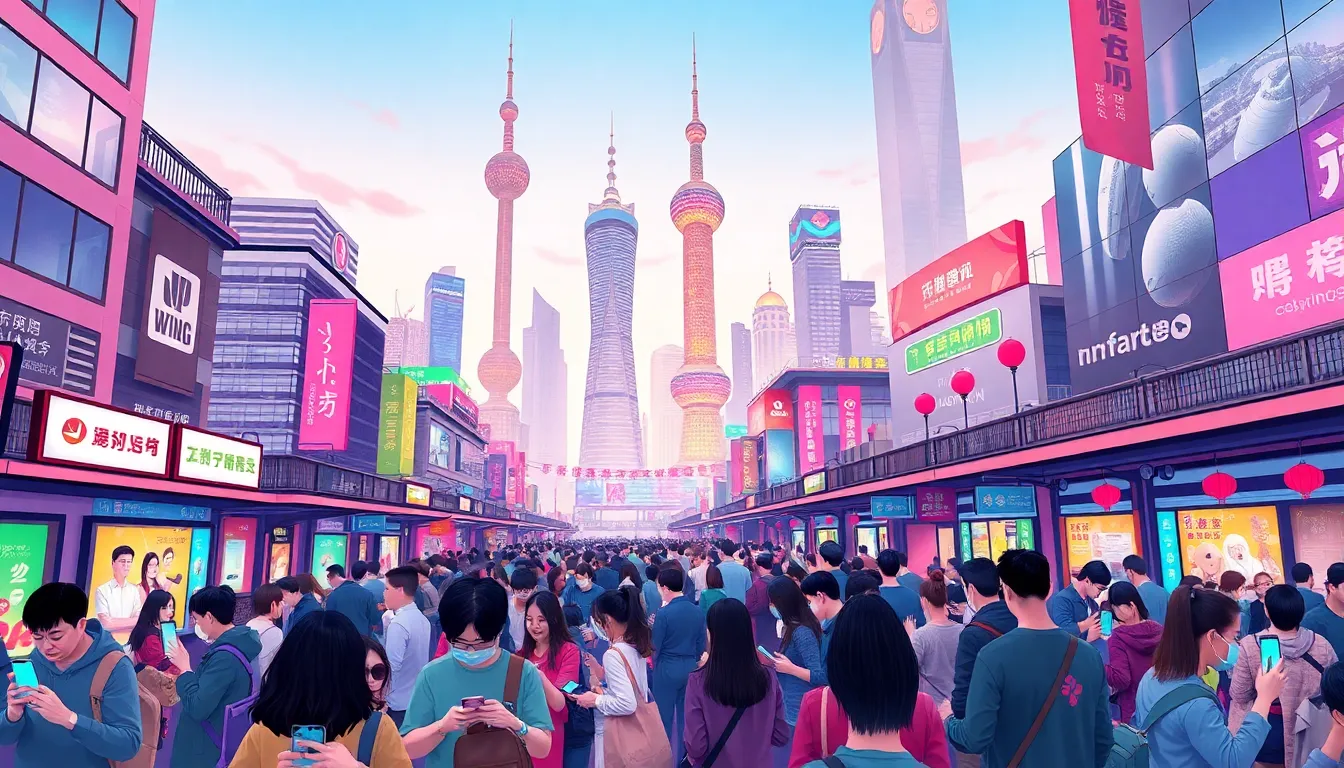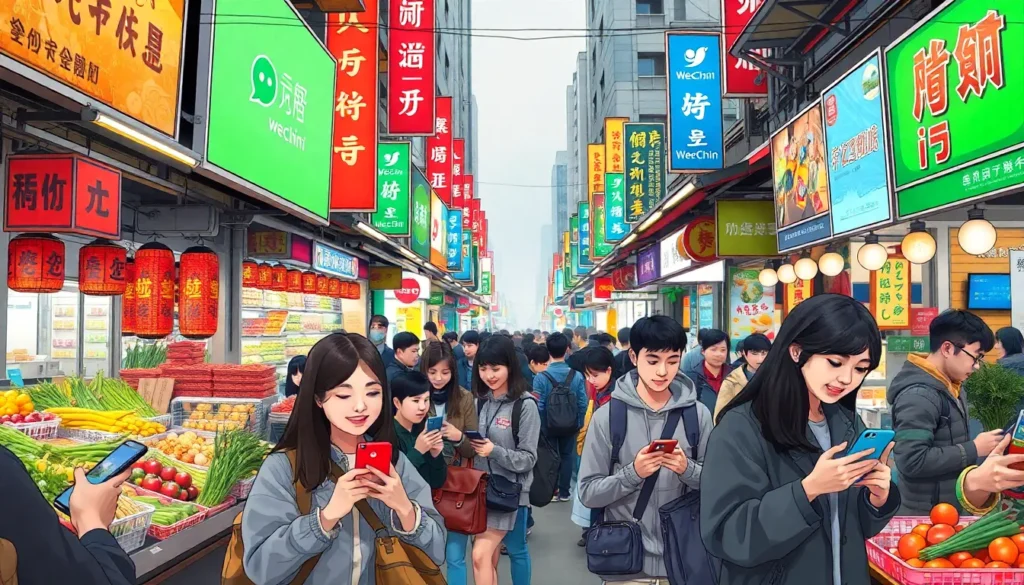In a world where social media rules the roost, China stands out with its unique digital playground. While platforms like Facebook and Twitter take a backseat, homegrown giants like WeChat and Douyin steal the spotlight. It’s like attending a party where everyone’s dancing to their own beat, and you just can’t help but join in the fun.
Table of Contents
ToggleOverview of Social Media in China
China’s social media landscape showcases a variety of local platforms that dominate user engagement. Attributes of these platforms create a unique environment distinct from global counterparts.
The Rise of Social Media Platforms
Social media platforms have flourished rapidly within China. Users gravitate toward local applications due to tailored experiences and cultural relevance. As of 2023, over 1 billion users engage with WeChat, which combines messaging, social media, and payment services. Douyin, the Chinese version of TikTok, also gained momentum, amassing around 600 million daily active users and attracting brands looking to connect with younger demographics.
Key Players in the Chinese Market
Major players lead the Chinese social media market. WeChat remains a multi-functional giant offering numerous services, thereby reinforcing its centrality in everyday life. Douyin is notable for its quick video content, captivating audiences and advertisers alike. Sina Weibo, often compared to Twitter, serves as an essential microblogging platform, enabling real-time news and trends. Additionally, platforms like Xiaohongshu focus on lifestyle sharing, blending e-commerce with social networking. These platforms illustrate a complex yet engaging landscape that shapes user interactions in China.
Popular Social Media Platforms

China’s social media landscape features several dominant platforms that cater to a vast user base and diverse interests. Notable examples include WeChat and Douyin, which lead in usage and engagement.
WeChat: The All-in-One App
WeChat serves multiple functions, integrating messaging, social media, and payment services within a single platform. Its user base exceeds 1 billion, highlighting its popularity among various demographics. Users can send messages, share images, and make payments seamlessly. Brands leverage WeChat for marketing through official accounts and mini-programs, which enhance customer engagement. The app’s versatility makes it essential for daily life in China, facilitating everything from social interactions to business transactions.
Douyin: A Short Video Sensation
Douyin stands out as China’s leading short video platform, attracting around 600 million daily active users. Content creators thrive here, producing engaging videos that resonate with younger audiences. Users can discover trends rapidly and participate in challenges that promote creativity. Businesses utilize Douyin for advertising, capitalizing on its high engagement rates. Its algorithm tailors content to individual preferences, ensuring users spend more time on the app. This combination of entertainment and commerce solidifies Douyin’s role in shaping the digital environment in China.
Unique Features of Chinese Social Media
Chinese social media platforms offer distinct characteristics that set them apart from global counterparts. Integration between social media and e-commerce plays a significant role in user experience.
Integration with E-commerce
WeChat exemplifies the fusion of social media with e-commerce. Users access mini-programs for shopping directly within the app, facilitating seamless transactions. Brands launch campaigns through official accounts, enhancing outreach and customer interaction. Douyin, on the other hand, has incorporated “shop now” features, allowing viewers to purchase products featured in videos instantly. This integration drives sales, as nearly 40% of users make purchases influenced by social media content. Platforms like Xiaohongshu further amplify this trend by combining lifestyle content with shopping experiences, catering to affluent consumers seeking inspiration.
Focus on User Engagement and Content Creation
User engagement remains a priority on Chinese social media, fueled by dynamic content creation tools. Douyin encourages creators to produce short, engaging videos, attracting high interaction rates. Algorithms play a pivotal role by providing users content tailored to preferences, ensuring relevance. WeChat features moments for sharing experiences and updates, fostering community connection. Microblogging on Sina Weibo supports real-time conversations and trending topics, driving user participation. Creators thrive in this interactive atmosphere, where nearly 80% of users actively engage with content, reinforcing the vibrant digital landscape in China.
Government Regulations and Censorship
China’s social media operates under stringent government regulations and censorship aimed at maintaining control over its digital landscape. Various laws govern online content, enforcing guidelines that limit freedom of expression and monitor digital interactions.
Overview of Internet Control in China
Internet control in China includes state-led censorship and surveillance measures. The Great Firewall restricts access to foreign websites, blocking platforms like Facebook, Twitter, and YouTube. Local platforms comply with state regulations, ensuring alignment with the Communist Party’s policies. Internet service providers monitor user activities, reporting any content deemed inappropriate or politically sensitive. Authorities continuously adapt laws to address emerging technologies, maintaining tight control over online discourse.
Impact on Social Media Usage
Regulations significantly impact how users engage with social media in China. Users often self-censor to avoid penalties or content removal. Local platforms like WeChat and Douyin implement strict content moderation, shaping user interactions and limiting discussions on sensitive topics. As a result, users gravitate towards humor, creativity, and indirect communication to navigate censorship effectively. Despite these restrictions, the social media environment remains dynamic, with users innovatively circumventing limitations while staying engaged.
The Role of Social Media in Chinese Society
Social media plays a crucial part in shaping communication and cultural dynamics in China. Local platforms facilitate connectivity among users, creating a vibrant digital landscape.
Communication and Connectivity
Platforms like WeChat enable instant messaging, social networking, and payment services in one app. They streamline daily interactions for over 1 billion users, influencing how relationships are formed and maintained. Douyin, with its engaging short videos, helps users share experiences and connect emotionally. Communication flourishes as users create and participate in group chats, sharing moments in real time. Users leverage social media for business networking, allowing for rapid information exchange and collaboration. Social media also fosters a sense of community, where individuals bond over shared interests and ideas.
Influence on Culture and Trends
Cultural trends emerge quickly on social media platforms, reshaping consumer behavior across China. Douyin’s algorithm promotes viral challenges, influencing fashion, food, and lifestyle choices. Young users, in particular, drive trends through user-generated content, making platforms essential for brand visibility. Social media not only shapes public opinion but also acts as a space for social commentary and activism. Sina Weibo serves as a hub for real-time news, allowing users to engage with current events and participate in discussions. Users often adopt and adapt global trends, making them culturally relevant within the Chinese context.
China’s social media landscape is a vibrant tapestry woven with unique platforms and cultural nuances. With WeChat and Douyin leading the charge, users find themselves in an engaging environment that blends communication, commerce, and creativity. This dynamic ecosystem not only shapes personal interactions but also influences broader cultural trends and consumer behaviors.
Despite strict regulations and censorship, creativity flourishes as users adapt and navigate challenges. The importance of social media in China extends beyond mere entertainment; it serves as a vital tool for connection, expression, and even activism. As this landscape continues to evolve, it will undoubtedly play a crucial role in the country’s digital future.








